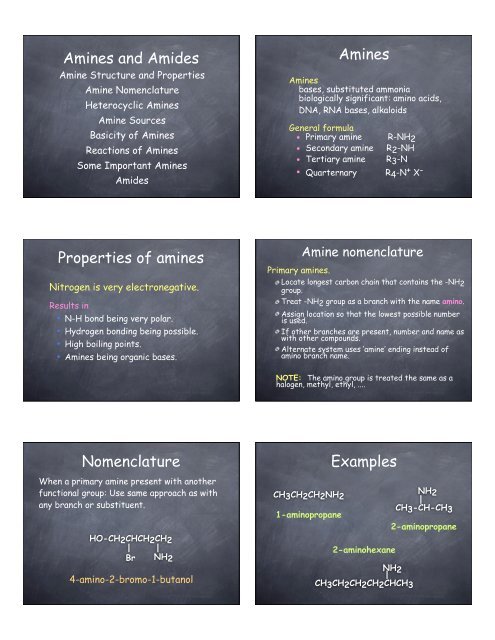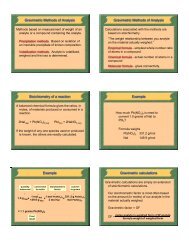Amines & Amides
Amines & Amides
Amines & Amides
You also want an ePaper? Increase the reach of your titles
YUMPU automatically turns print PDFs into web optimized ePapers that Google loves.
<strong>Amines</strong> and <strong>Amides</strong><br />
Amine Structure and Properties<br />
Amine Nomenclature<br />
Heterocyclic <strong>Amines</strong><br />
Amine Sources<br />
Basicity of <strong>Amines</strong><br />
Reactions of <strong>Amines</strong><br />
Some Important <strong>Amines</strong><br />
<strong>Amides</strong><br />
Properties of amines<br />
Nitrogen is very electronegative.<br />
Results in<br />
• N-H bond being very polar.<br />
• Hydrogen bonding being possible.<br />
• High boiling points.<br />
• <strong>Amines</strong> being organic bases.<br />
Nomenclature<br />
When a primary amine present with another<br />
functional group: Use same approach as with<br />
any branch or substituent.<br />
HO-CH2CHCH2CH2<br />
| |<br />
Br NH2<br />
4-amino-2-bromo-1-butanol<br />
<strong>Amines</strong><br />
<strong>Amines</strong><br />
bases, substituted ammonia<br />
biologically significant: amino acids,<br />
DNA, RNA bases, alkaloids<br />
General formula<br />
• Primary amine R-NH 2<br />
• Secondary amine R 2 -NH<br />
• Tertiary amine R3-N<br />
• Quarternary R 4 -N + X -<br />
Primary amines.<br />
Amine nomenclature<br />
Locate longest carbon chain that contains the -NH2<br />
group.<br />
Treat -NH2 group as a branch with the name amino.<br />
Assign location so that the lowest possible number<br />
is used.<br />
If other branches are present, number and name as<br />
with other compounds.<br />
Alternate system uses ‘amine’ ending instead of<br />
amino branch name.<br />
NOTE: The amino group is treated the same as a<br />
halogen, methyl, ethyl, ....<br />
CH3CH2CH2NH2<br />
1-aminopropane<br />
Examples<br />
2-aminohexane<br />
NH2<br />
|<br />
CH3CH2CH2CH2CHCH3<br />
NH2<br />
|<br />
CH3-CH-CH3<br />
2-aminopropane
Nomenclature<br />
Secondary and Tertiary amines<br />
• Treat additional branches as a branch on<br />
the nitrogen.<br />
• Base name is based on longest chain that<br />
contains the amine.<br />
• Name other chain as alkyl substituent on<br />
the nitrogen.<br />
• Use N- at front of a branch name<br />
indicates that substituent is on the<br />
nitrogen.<br />
Examples<br />
(CH3CH2)2NCH3<br />
N-ethyl-N-methylaminoethane<br />
CH3-CH-CH2-NH2<br />
|<br />
NH2<br />
1,2-diaminopropane<br />
CH3<br />
CH3-C-CH-CH3<br />
|<br />
H2N OH<br />
3-amino-3-methyl-2-butanol<br />
Nomenclature<br />
Some common names<br />
methyl amine CH 3 -NH 2<br />
dimethyl amine CH 3 -NH-CH 3<br />
ethyl amine CH 3 -CH 2 -NH 2<br />
methyl ethyl amine CH3-NH-CH2-CH3<br />
Common approach is to give alkyl name with<br />
amine ending.<br />
|<br />
|<br />
Examples<br />
CH3CH2CH2-NH-CH3<br />
N-methyl-1-aminopropane<br />
N<br />
CH 3<br />
CH 3<br />
N,N-dimethylaminocyclohexane<br />
Nomenclature<br />
Many aromatic amines have special names<br />
that have been accepted as IUPAC names.<br />
NH 2<br />
NH 2<br />
CH 3<br />
NH 2<br />
CH 3<br />
NH 2<br />
aniline p-toluidine o-toluidine m-toluidine<br />
Heterocyclic amines<br />
Ring structures that have one or more<br />
nitrogen contained within the ring.<br />
N<br />
H<br />
N<br />
Pyrrole Pyridine<br />
CH 3
H 3 CO<br />
Heterocyclic amines<br />
N<br />
H<br />
N N<br />
M +<br />
Indole Porphyrin<br />
<strong>Amines</strong> of medical interest<br />
Many amines have ‘interesting’ medical uses.<br />
Analgesics<br />
H<br />
O<br />
||<br />
NH-C-CH3<br />
|<br />
|<br />
OCH 2 CH 3<br />
Phenacetin Acetaminophen<br />
(APC tablets) (Tylenol)<br />
N<br />
N<br />
O<br />
||<br />
NH-C-CH3<br />
|<br />
|<br />
OH<br />
Heterocyclic drugs<br />
C H<br />
O<br />
N<br />
O<br />
CH 3<br />
Cocaine<br />
O<br />
C<br />
H 3 CH 2 C<br />
O<br />
C<br />
N<br />
N<br />
H<br />
CH 2 CH 3<br />
N<br />
CH 3<br />
lysergic acid<br />
diethylamide (LSD)<br />
HO<br />
Heme<br />
Medically important amines<br />
Amphetamines<br />
Stimulate central nervous system.<br />
benzidrine<br />
Barbituates<br />
Depress central nervous<br />
system.<br />
barbital<br />
O<br />
HN CH 3<br />
CH<br />
C CH3<br />
H2 N<br />
N<br />
O<br />
O<br />
CH 2 CH 3<br />
CH 2 CH 3<br />
Neurotransmitters<br />
Chemicals that pass signals<br />
between nerve cells.<br />
N<br />
H<br />
Serotonin<br />
CH 2 CH 2 NH 2<br />
CH3 N +<br />
CH 3<br />
O<br />
H 3 C CH 2 CH 2 O<br />
C<br />
Acetylcholine<br />
CH 3
Viagra<br />
Production of amines<br />
Laboratory sources<br />
from amides<br />
O<br />
||<br />
CH3CH2CH2-C-NH2 from nitro compounds<br />
NO 2<br />
[R]<br />
Formation of <strong>Amides</strong><br />
Amide -<br />
[R]<br />
NH 2<br />
CH 3 CH 2 CH 2 CH 2 -NH 2<br />
Reactions of amines<br />
amine derivative of a carboxylic acid.<br />
General formula<br />
O<br />
||<br />
R-C-NH2<br />
Sources of amines<br />
Industrial sources<br />
Production from ammonia and an alcohol.<br />
NH 3 + CH 3OH<br />
CH 3NH 2 + NH 3<br />
(CH 3)NH + NH 3<br />
Al 2O 3<br />
heat<br />
Al 2O 3<br />
heat<br />
Al 2O 3<br />
heat<br />
CH 3NH 2 + H 2O<br />
(CH 3) 2NH + H 2O<br />
(CH 3) 3N + H 2O<br />
Basicity of amines<br />
<strong>Amines</strong> react with acids much like ammonia.<br />
H<br />
|<br />
R-N:<br />
|<br />
H<br />
+ HCl<br />
H<br />
|<br />
R-N-H + Cl- H |<br />
+<br />
Results in salt formation.<br />
Amide nomenclature<br />
Similar to carboxylic acid.<br />
Drop -oic acid ending and replace with amide<br />
O<br />
||<br />
CH3-CH2-C-NH2<br />
Propanamide<br />
O NH2 C<br />
Benzamide
Preparation of amides<br />
Production from a carboxylic acid<br />
O<br />
||<br />
CH3-CH2-C-OH<br />
NH3 heat<br />
O<br />
||<br />
CH3-CH2-C-NH2<br />
Production from an acid chloride<br />
C<br />
O<br />
Cl<br />
NH 3<br />
heat<br />
Amino acids<br />
C<br />
O<br />
NH 2<br />
We rely on amide bonds when we build<br />
proteins from amino acids.<br />
General<br />
structure<br />
of an<br />
amino acid.<br />
H<br />
R C<br />
NH 2<br />
C<br />
O<br />
OH<br />
NOTE: We will cover this in<br />
much more detail in Ch. 19.<br />
Acid group<br />
Base group<br />
They are too close<br />
to each other to<br />
form an amide.<br />
Nylon<br />
If we have a diamine and a diacid chloride, we can produce<br />
a polymer using amide bonds. Nylon is an example.<br />
O<br />
O<br />
hexamethylenediamine<br />
n Cl C (CH2 ) 4 C Cl + n H2N (CH2 ) 6 NH2 adipoyl chloride<br />
O O<br />
Amide<br />
linkage<br />
H 2 N<br />
* C<br />
H H<br />
(CH2 ) 4 C N (CH2 ) 6 N *<br />
n<br />
polyamide nylon<br />
The peptide bond<br />
Proteins are polymers made up of amino acids.<br />
Peptide bond (amide linkage)<br />
How the amino acids are linked together<br />
to form a protein.<br />
H<br />
C<br />
R<br />
O<br />
C<br />
H<br />
OH H2N C C<br />
R'<br />
O<br />
H 2 N<br />
OH<br />
H<br />
C<br />
R<br />
O<br />
C<br />
H<br />
H<br />
N C C<br />
R'<br />
O<br />
OH



